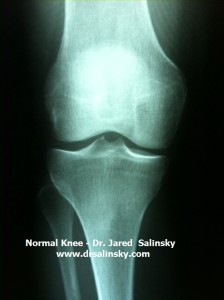Meniscus Tear
A meniscus is a cartilage structure in a joint that acts like a shock absorbing cushion. Many joints have a meniscus but the most commonly talked about meniscus is in the knee. There are actually two in the knee: one on the inside (medial) and one on the outside (lateral). They grow as we grow until about the age of 15 or so, and then they begin to slowly degenerate. They gradually weaken and can tear from a simple mis-step. Meniscus tear of the knee is the most common diagnosis in orthopedics. And arthroscopy for treatment of meniscus tears is the most commonly performed surgery by orthopedic surgeons. An MRI is used to confirm the diagnosis.
Meniscus tears can occur traumatically from a jerk or rapid twist of the knee. Soccer, football and basketball are typical sports associated with meniscus tears. Landing awkwardly from a simple jump can also cause a tear. Frequently however people just come in the office complaining of knee pain that clinically appears to be a tear. An MRI is ordered and usually will show the tear. Some studies reveal that as many as 40% of people in the general public have some form of meniscus pathology and don’t even know it.
Center for Bone and Joint Disease (352) 596-0900
 Meniscus tears also frequently occur in people whose knees are developing arthritis. As the ends of the femur (thigh bone) begin to change shape from the arthritis they exert an uneven elevated stress on the cartilage. Eventually the meniscus can give way as it tears under the pressure of the mis-shapen femoral condyles. These tears can cause sudden sharp pain or remain dull and achy for years until it is diagnosed. The most common diagnosis is the postero-medial meniscus tear.
Meniscus tears also frequently occur in people whose knees are developing arthritis. As the ends of the femur (thigh bone) begin to change shape from the arthritis they exert an uneven elevated stress on the cartilage. Eventually the meniscus can give way as it tears under the pressure of the mis-shapen femoral condyles. These tears can cause sudden sharp pain or remain dull and achy for years until it is diagnosed. The most common diagnosis is the postero-medial meniscus tear.
Some small incidentally found meniscus tears may not need surgery. But, a meniscus can not heal on its own as it has a poor blood supply and no nerve supply. Unfortunately most tears will require surgery. It can be done through 2 small portals and takes as little as 10 minutes (but as long as 30 minutes). Most tears need to be shaved down to a smooth margin; this is done with small biters and an oscillating shaver. The surgery is done in an outpatient surgery setting and you can walk the same day! The pain is minimal and easily controlled with a mild narcotic. The stitiches are removed within 5 days and physical therapy is usually ordered for a week or two, depending on the individual. We do fix certain tears in younger people but this is much more atypical and the rehabilitation protocol is much more difficult.


